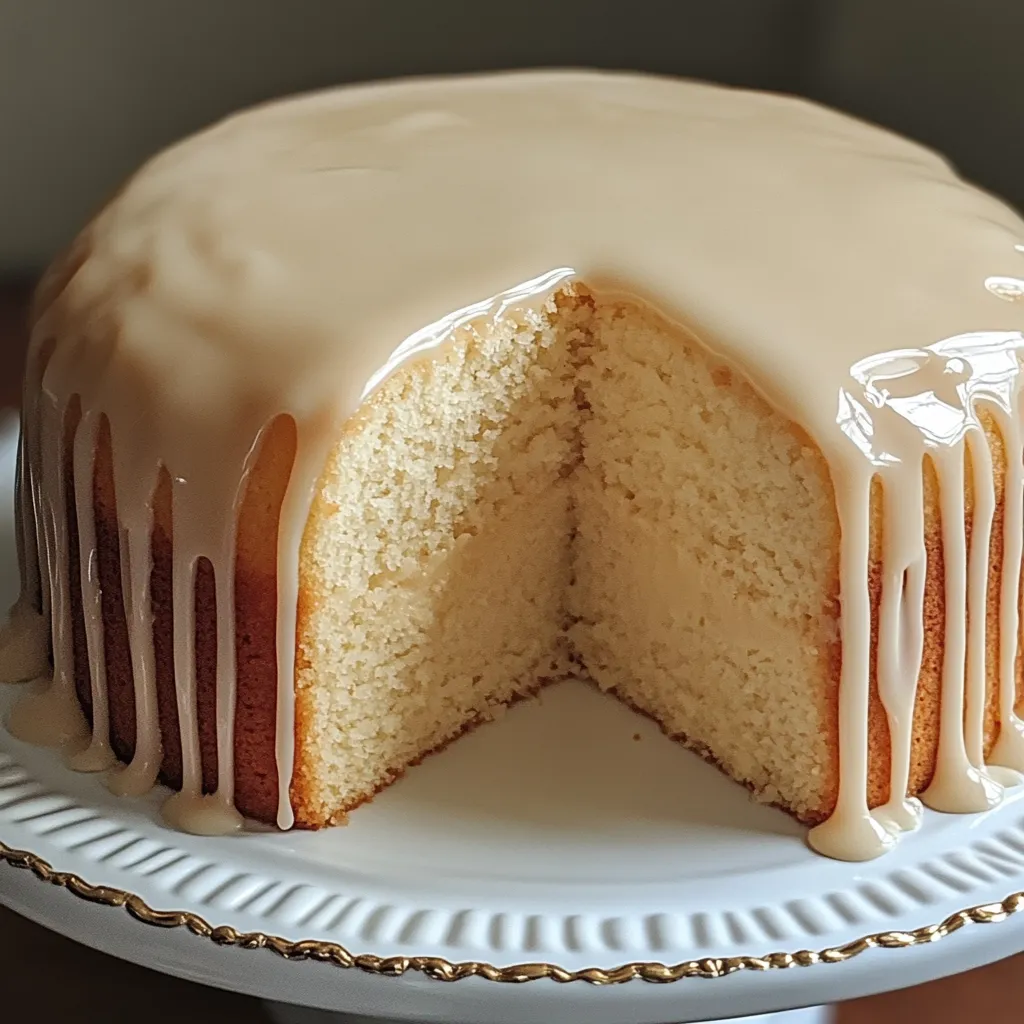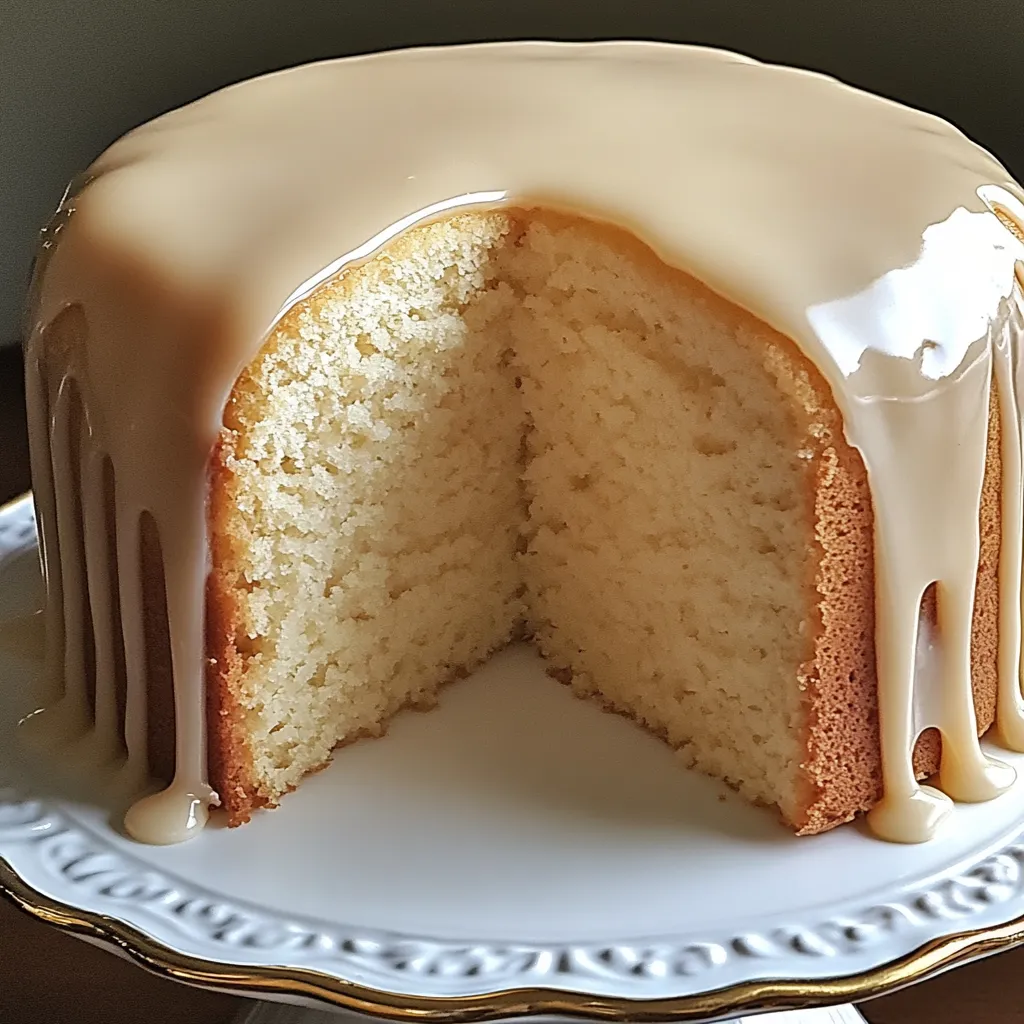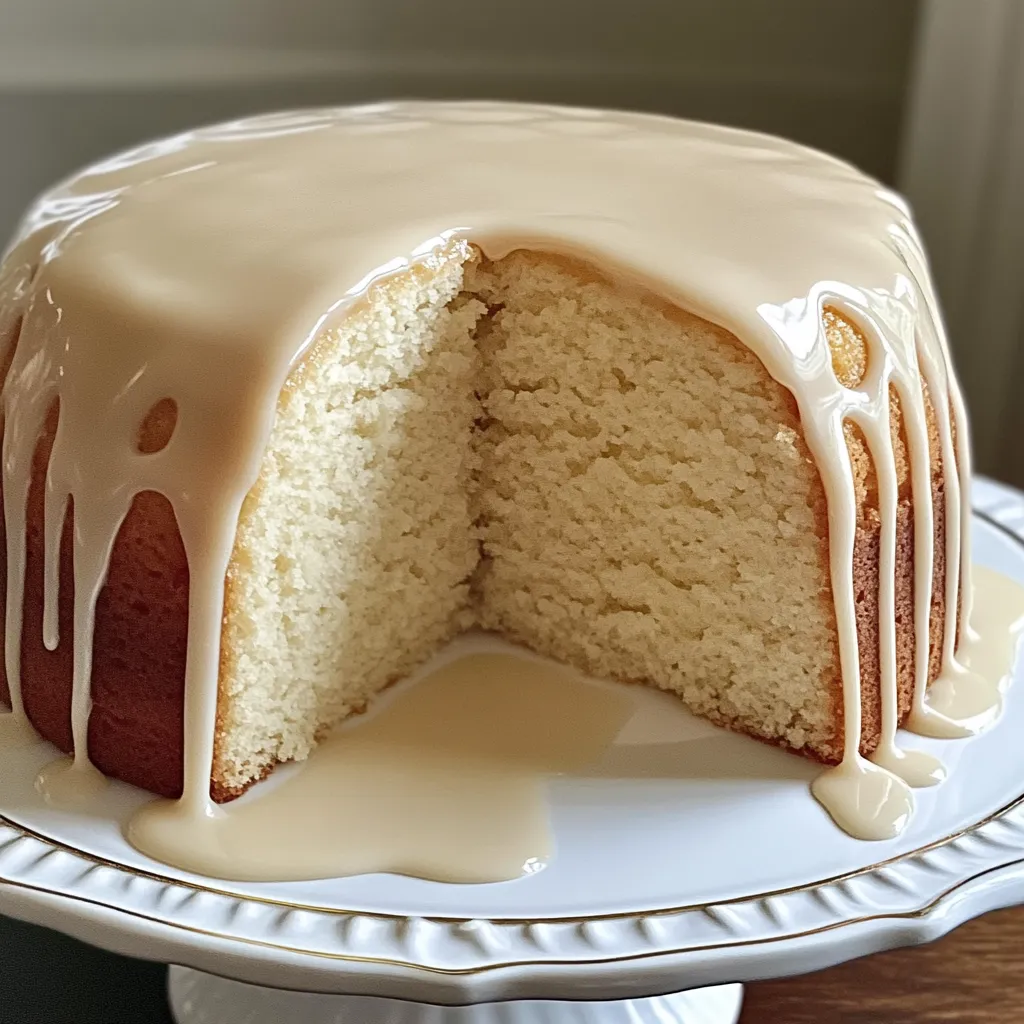 Pin
Pin
Buttermilk Vanilla Cake with Cream Cheese Glaze turns everyday kitchen staples into a rich, smooth treat with just the right mix of sweet and tangy flavors. The buttermilk does wonders in the mix, giving you an incredibly soft texture with a slight tang that works beautifully with the rich vanilla running through every bite. When it comes out of the oven, you'll get that gorgeous golden crust that breaks away to reveal a soft, buttery center that just melts away as you eat it. Topped with a smooth cream cheese glaze that slowly runs down the sides, making it look amazing while adding a tangy kick to counter the sweetness, this classic dessert turns any regular day into something special with its unfussy elegance.
I came up with this recipe while trying to find a pound cake that wouldn't dry out after one day. After trying lots of different wet ingredients, buttermilk came out on top, changing a decent pound cake into something really special. The first time I brought this to a family event, my grandma—who's super picky about baking—asked me how I made it, saying it was better than the traditional recipe she'd been using for over 50 years. That's when I knew I'd nailed it, and I haven't changed a thing about the recipe as I've made it for everything from casual coffee meetups to big holiday parties.
Perfect Ingredients
- All-purpose flour (3 cups): Gives you the right base while keeping things tender
- Baking powder (1 teaspoon): Makes it rise just enough without losing that dense texture
- Salt (½ teaspoon): Brings out all the tastes and cuts through the sweetness
- Unsalted butter (1 cup, softened): Adds that rich taste and classic pound cake feel
- Granulated sugar (2 cups): Sweetens while helping get that smooth, fine texture
- Large eggs (4, room temperature): Give structure, richness, and that nice yellow color
- Vanilla extract (2 teaspoons): Adds that warm, sweet smell throughout
- Buttermilk (1 cup, room temperature): Makes sure the cake stays super moist with a tender bite
- Cream cheese (4 oz, softened): Makes the base for a tangy topping that works with the sweet cake
- Powdered sugar (1 cup): Makes a smooth, sweet glaze with no grainy texture
- Milk or heavy cream (2-3 tablespoons): Thins the glaze to just the right thickness
Cake Creation
Careful Preparation
Start by getting your bundt pan ready, since this step decides how nicely your cake will come out. Cover every part with soft butter, making sure to get the middle tube and any fancy patterns. Sprinkle flour over the buttered parts and tap out what's left over. This key step makes sure your cake won't stick and will keep its pretty shape. At the same time, let your cold stuff—butter, eggs, and buttermilk—warm up to room temperature. This small detail actually makes a huge difference in how your cake turns out, since room temperature ingredients mix better and trap more air than cold ones do.
Butter Transformation
With your mixer, beat the soft butter and sugar at medium speed for a full 5 minutes, until you can see it's much lighter in color and fluffier. Don't cut this mixing time short—it's not just a suggestion but a must for getting air into the mix that makes your cake's texture so good. The butter and sugar should change from thick and yellow to fluffy and almost white. Bakers call this creaming, and it's what makes your cake's texture. Taking your time here will get you a lighter, softer cake instead of a heavy one.
Egg Integration
Put the eggs in one at a time, mixing well after each one until it's completely mixed in before adding another. This way works best to stop the mix from getting lumpy and makes sure each egg blends in properly. After all eggs are in, mix in the vanilla extract until everything looks smooth. The mix might look a bit separated at this point—don't worry, that's normal and will get fixed when you add the dry stuff. The eggs don't just add richness, they also help the cake hold together and give it that nice golden color when it's done.
Gentle Alternating
In another bowl, mix your flour, baking powder, and salt until they're all combined. Add these dry ingredients to your butter mix in three batches, switching with two pours of buttermilk, starting and ending with the dry mix. Mix on low just until everything comes together, and scrape the sides of the bowl between additions. This back-and-forth method keeps the cake from getting tough by not letting too much gluten form. When you're done, the batter should look smooth and thick, dropping slowly off the beater in a silky way.
Careful Baking
Put the batter in your prepared pan, smoothing the top with a spatula so it's even. Bake in a 325°F oven that's already hot for about 60-65 minutes. The lower heat lets the cake cook slowly and evenly, so the outside doesn't get too dark before the inside is done. You'll know it's ready when a wooden pick stuck in the middle comes out clean or with just a few moist crumbs, and the top bounces back when you touch it lightly. Try not to open the oven during the first 45 minutes—those temperature changes can make your cake sink in the middle.
Cooling Patience
Let your finished cake cool in the pan for exactly 10 minutes—this timing really matters. If you take it out too early, it might break apart; too late and it could get stuck. After those 10 minutes, flip the cake onto a wire rack and carefully lift the pan off. Let it cool all the way to room temperature before adding the glaze, which takes about 2 hours. This cooling time lets the cake set up and the flavors come together. It's tempting to glaze it while it's warm, but don't—the glaze will just melt and soak in rather than making those pretty drips down the sides.
Glaze Perfection
While your cake cools, make the cream cheese glaze by beating soft cream cheese until it's totally smooth. Slowly add the powdered sugar and vanilla, mixing until they're fully combined. Add milk or cream one spoon at a time until you get a glaze that's runny enough to pour but thick enough to stick to the cake. When the cake is totally cool, put it on a serving plate and pour the glaze over the top, letting it run down the sides naturally. For a fancier look, use a spoon to guide the glaze into the cake's grooves.
 Pin
Pin
My grandma always said a real pound cake should be solid enough to feel substantial but soft enough to melt as you eat it. She taught me that good ingredients and taking your time matter more than fancy add-ins. This recipe follows her advice while adding buttermilk for extra moisture and flavor depth. Whenever I cut into this cake, I think about her kitchen—how she'd check if it was done by listening to it ("It shouldn't make noise," she'd tell me) and how she never rushed cooling it down. These tiny but important details turn a basic cake into something really special.
Serving Suggestions
Give slices of this fancy pound cake on small plates with forks for a nice touch. For a casual brunch, set out some fresh berries and whipped cream so guests can add what they want. In summer, try it with a scoop of vanilla ice cream or lemon sorbet that starts to melt into the cake. For holiday meals, sprinkle a little cinnamon or fresh nutmeg over the glazed cake. This go-to cake tastes great with coffee or tea, making it perfect for afternoon get-togethers or as a classy way to end dinner.
Creative Variations
Switch up this classic cake by trying different flavors and mix-ins. For a citrus twist, add the zest from two lemons or oranges to your batter and swap some vanilla extract with fresh juice in both the cake and glaze. Make a cool marble pattern by taking out a cup of batter, mixing in three tablespoons of cocoa powder, and swirling it through the vanilla batter before you bake. For the holidays, add ½ teaspoon of almond extract to the batter and top the glazed cake with toasted sliced almonds and candied cherries. In fall, throw in warm spices like cinnamon, nutmeg, and cloves for a spiced version.
Storage Success
This cake stays moist really well when kept at room temperature in an airtight container for up to three days. If you need it to last longer, stick it in the fridge for up to a week, but let slices warm up before eating for the best taste and texture. For even longer storage, freeze the cake without glaze, wrapped tight in plastic wrap and then foil for up to three months. Let it thaw in the fridge overnight while still wrapped, then bring to room temp and add fresh glaze before serving. You can also freeze single slices to control portions and enjoy it longer.
I've tried tons of pound cake recipes over the years, but this buttermilk version is still my go-to because it hits that sweet spot between simple and fancy. There's something really satisfying about a dessert that doesn't need tricks or gimmicks to impress—just good ingredients handled with care and attention. What makes this cake really special is how it brings people together, creating those shared moments whether you're serving it at a big holiday dinner or just having coffee with a friend. It reminds me that sometimes the most memorable food comes from getting the classics just right instead of always chasing after something new.
 Pin
Pin
Recipe Questions & Answers
- → Can I bake this without using a bundt mold?
- Of course! Two 9x5 loaf tins work great. Just lower the baking time to around 45-55 minutes and stick a skewer in to check if it's done.
- → When’s the pound cake considered ready?
- When the center toothpick comes out clean or shows a teeny bit of crumb, and the top has browned while pulling slightly away from its pan edges.
- → What’s with the crack on top?
- Totally normal, no stress! Pound cakes form cracks as their outside cooks before the center. This is traditional and gives it extra charm.
- → Any other flavor twists for this cake?
- For sure! Add zesty lemon or orange, almond essence, or fold some berries in. Spices like cinnamon or nutmeg make a cozy version too.
- → Why do recipes often require buttermilk here?
- Buttermilk brings a slight tang while it tenderizes the dough, breaking down gluten. The result? Softer texture and unbeatable moistness.
